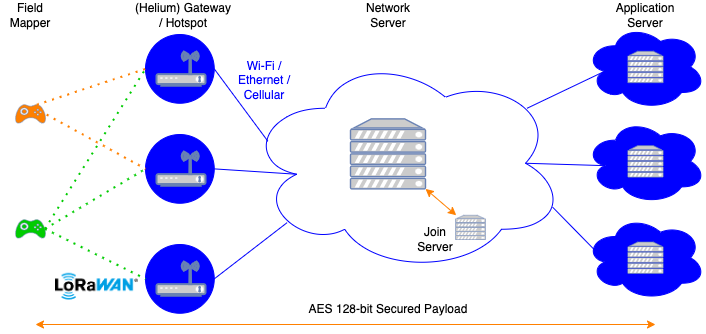LoRaWAN Mapper – Overview
This blog is part 1 of a 4-part series on LoRaWAN field mappers. For related information checkout the following posts:
LoRaWAN Mapper – using WisToolBox (iOS)
LoRaWAN Mapper – using Helium Console
Introduction to LoRaWAN
LoRaWAN is a LOng RAnge, low power, low bit rate, wireless platform used in IoT applications. Low bit rate means 0.3 to 50 kbits/s using spread spectrum modulation derived from chirp spread spectrum (CSS). LoRa is the silicon (layer 1 or PHY) developed by Semtech and LoRaWAN (upper layers) is the standard developed by the LoRa Alliance, managing the interoperability standard, communication protocol, and software standard.
Key features of LoRa include:
- Long Range: Supports connections up to 50 Km apart in rural areas with excellent penetration in urban or indoor environments
- Low Power: Requires minimal energy, allowing prolonged operation on coin-cell batteries or via energy harvesting
- End-to-end Security: Uses AES 128-bit encryption, mutual authentication, integrity protection, and confidentiality
- Geolocation: Locate and track devices or objects
- Mobile: Supports communications with devices in motion
- High Capacity: Not with respect to throughput, rather LoRa supports millions of messages per base station
- Low Cost: Reduces infrastructure investment and battery replacement expenses
LoRa fills a gap in the bandwidth vs range model offered by traditional wireless technologies while offering substantially lower infrastructure investment.

LoRaWAN is supported globally via license-free, sub-GHz radio frequencies, typically landing in the 868/900 MHz ISM band. A subset of frequencies and regulatory domains is listed in the table below:

A more detailed list of frequencies offered in various regulatory domains can be found in the Regional Parameters available from the LoRa Alliance.
Why MAP LoRaWAN Coverage?
Mapping LoRaWAN coverage serves several purposes:
- Optimize location for devices – Know where sensors, actuators, or tags can be setup successfully
- Optimize location for gateways – Quantify the performance of existing gateway(s) and their location
- Network coverage testing – Create a map detailing coverage area of gateway(s) with signal strength (RSSI) and quality (SNR)
- Indoor testing – Measure how buildings affect your network
- Testing with different antennas – Learn about RF by changing antennas and communication parameters such as DR and Tx Power
- Visualization of all data – Who doesn’t enjoy looking at a visual coverage heatmap?
- LEARNING about LoRaWAN – The best way to improve knowledge about how LoRaWAN and RF work is to make it practical.
What is Helium
Helium is a community driven, open-source block chain network designed to expand wireless coverage globally for IoT devices. To build out Helium, new gateways are ideally placed in areas not currently served – accomplishing two goals – expanding network coverage and maximizing the credits earned from gateway placement. Helium mappers are useful tools to find those ideal locations and determine if new sensors are within range of an existing gateway.
- Testing location for HELIUM hotspot placement – You can see how many hotspots are visible from some locations, if any, before setting up your hotspot.
LoRaWAN Field Mapper Architecture Overview
The mapping architecture uses the following components:
Field Mapper: Handheld/mobile device used by end user to map network coverage. In a typical LoRaWAN architecture, this would be referred to as the device (i.e. sensor or actuator).
Gateway / Hotspot: Collects and forwards messages sent by field mappers. Multiple gateways / hotspots can receive the same message and all gateways will forward messages to the network server.
Network Server: Responsible for connectivity, management, and monitoring of both devices and gateways. It’s tasked with ensuring security, scalability, and reliability of data routing throughout the network. Additionally, it de-duplicates identical messages received from multiple gateways.
Application Server: Handles uplink/downlink data decryption and decoding, along with downlink queuing. Additionally, it hosts application layer services such as MQTT, HTTP webhooks and pub/sub integrations.

Slàinte!
Resources
LoRaWAN Alliance
Semtech
RP2-1.0.3 LoRaWAN Regional Parameters Guideline
LoRaWAN Geolocation White Paper